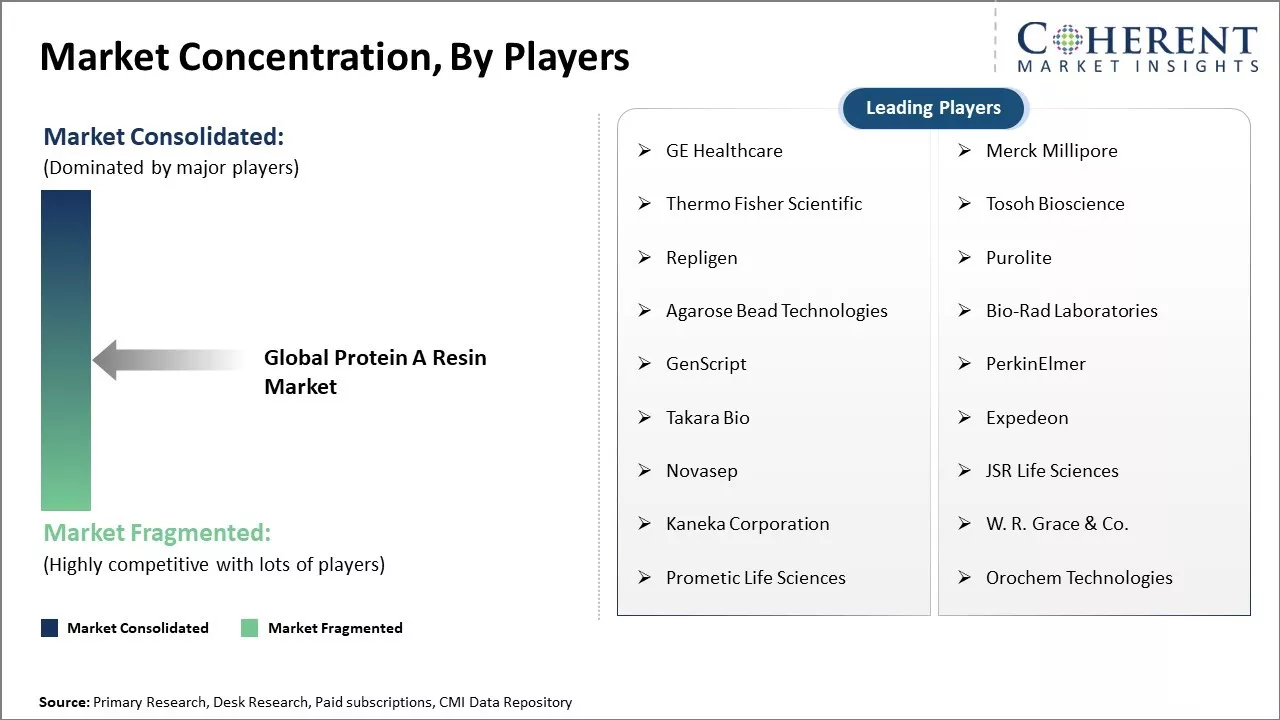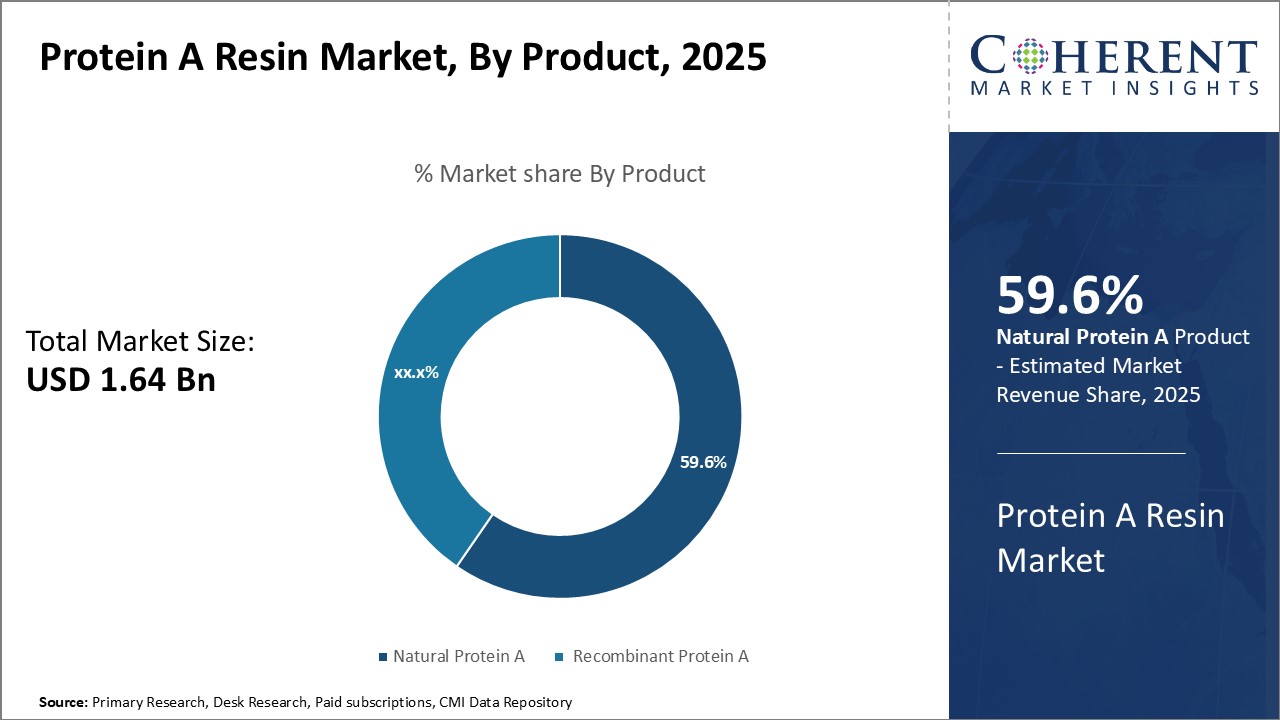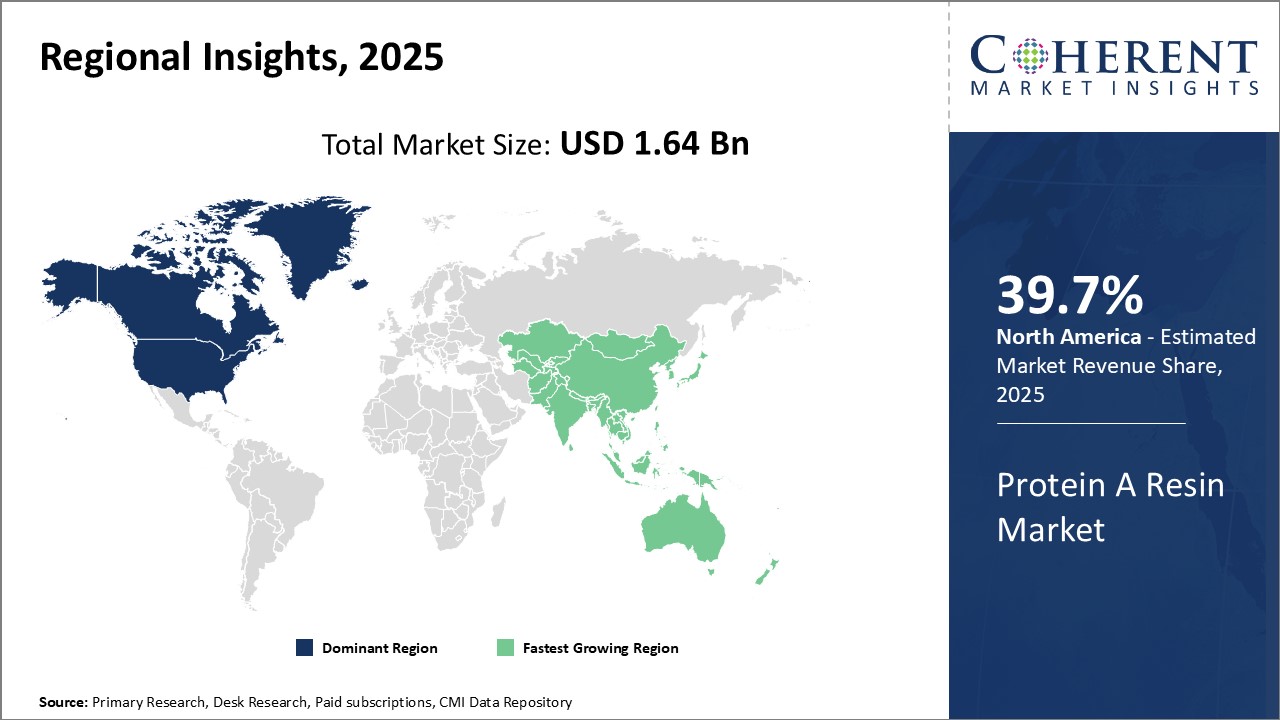The Global Protein A Resin Market is estimated to be valued at USD 1.64 Bn in 2025 and is expected to reach USD 3.13 Bn by 2032, exhibiting a compound annual growth rate (CAGR) of 9.7% from 2025 to 2032.

Discover market dynamics shaping the industry: Download Free Sample
The market is expected to witness positive growth over the forecast period. Growing biopharmaceutical industry and increasing research and development activities in pharma and biotech companies are expected to drive the demand for protein A resins. Additionally, the increasing production of monoclonal antibodies for therapeutic applications will also contribute to the growth of the protein A resin market. Furthermore, the growing prevalence of chronic diseases globally is increasing the demand for biologic drugs, which, in turn, is propelling the market growth. However, availability of alternative affinity chromatography resins may hinder the market growth of protein A resin to a certain extent during the forecast period.
Increasing focus on developing biologics such as monoclonal antibodies (mAbs) for therapeutic purposes
The demand for monoclonal antibody therapies is increasing rapidly owing to their high specificity and ability to treat various chronic and life-threatening diseases. Protein A resin plays a critical role in the downstream purification process of monoclonal antibodies during their production. As the development and approval of novel monoclonal antibodies continue to grow for indications like cancer, autoimmune disorders, and infectious diseases, the requirement for protein A resin is expected to rise substantially. Major pharmaceutical companies are making heavy investments in developing highly innovative monoclonal antibody drugs and bringing them into the market. This massive pipeline of monoclonal antibodies in clinical trials and extensive research on complex antibody therapeutics will drive the need for large volumes of protein A resins over the coming years. For instance, in March 2025, ClinicalTrial.gov reported 1,248 ongoing clinical studies focused on monoclonal antibodies in the U.S. This significant number underscores a robust biopharmaceutical development pipeline centered around monoclonal antibodies. Consequently, the increasing demand for protein A resins is closely aligned with scaling purification and production processes, thereby driving the market growth in this sector.

Get actionable strategies to beat competition: Download Free Sample
Growth of Biosimilars Industry
The commercialization of many blockbusters biologic drugs is expected to lose patent protection in the upcoming years, opening vast opportunities for biosimilar products. Several pharmaceutical vendors are entering the biosimilars space and are engaged in the development of low-cost versions of popular biologics like monoclonal antibodies, hormones, cytokines, and clotting factors. Since protein A resin demonstrates high affinity and specificity for immunoglobulin G (IgG) molecules, it serves as an imperative technology in the downstream purification step of biosimilar manufacturing processes. The increasing biosimilars approvals and expanding global biosimilars market size will propel the demand for protein A resins from biosimilar companies. Many leading players are also focusing on enhancing protein A resin capabilities to fast-track the production of biosimilars. This is anticipated to substantially augment the growth of the protein A resin market in the foreseeable future.
Key Takeaways from Analyst:
The global protein A resin market is expected to witness steady growth over the forecast period driven by the increasing demand for monoclonal antibody-based therapeutics. Protein A resins are widely used in the downstream processing of monoclonal antibodies during purification steps. Rising investments in healthcare infrastructure and growing monoclonal antibody therapeutics pipeline will further propel the demand for protein A resins.
North America currently dominates the global protein A resin market owing to a strong presence of pharmaceutical companies and expanding biologics industry in the region. However, Asia Pacific is likely to emerge as the fastest growing market as regional governments are increasingly focusing on enhancing healthcare facilities and pharmaceutical investments.
Fluctuations in raw material prices remain a key challenge for protein A resin manufacturers. Stringent regulatory compliance for downstream processing also increases complexity and costs. Furthermore, slower than expected approvals for biosimilars in developed markets can hamper market opportunities.
New product launches with improved performance characteristics presents profitable opportunities for market players. In addition, growing outsourcing of bioprocessing activities from mature markets to Asian countries will create lucrative opportunities. Key players are investing in R&D to develop protein A resin with enhanced binding capacities and longer shelf life to cater emerging demand from biopharmaceutical companies.
Market Challenges: High costs associated with Protein A resins
The high costs associated with Protein A resins is one of the major factors restraining the growth of the global Protein A resin market. Protein A resins are expensive chromatography media used routinely in the downstream purification processes of monoclonal antibody manufacturing. The cost of resins contributes significantly to the overall production costs for biopharmaceutical companies. Protein A resin needs to be replaced on a regular basis as it has durability limitations. It can be effectively used only for a certain number of purification cycles before the binding capacity reduces significantly. Companies need to purchase fresh resins frequently to sustain production. This repetitive capital expenditure on resins every year burdens the budget of companies. The high resin replacement cost discourages wider adoption of Protein A chromatography techniques, especially in developing economies. It also disincentivizes research initiatives involving large-scale screening of monoclonal antibodies.
Market Opportunities: Emerging markets in Asia Pacific and Latin America
The emerging markets in Asia Pacific and Latin America present a huge growth opportunity for the Global Protein A Resin Market. These regions are witnessing rapid economic development and rise in disposable income levels, which is driving increased healthcare spending. At the same time, the prevalence of chronic diseases is also on the rise in countries such as China, India, Brazil, and Mexico due to aging population and changing lifestyles. This is generating high demand for biologics and monoclonal antibody-based drugs which are used for the treatment of cancer, autoimmune disorders, and other complex diseases. Protein A resin is a critical component used in the downstream purification process of monoclonal antibody production. With the biologics industry shifting focus towards these emerging regions to cater to the growing in-house demand, there will be a parallel rise in need for protein A resins. Both multinational pharma companies as well as the domestic players in these markets are expanding and establishing new manufacturing facilities for biologics. For instance, recent data from the International Trade Administration shows that FDI inflows for the biopharma sector increased by 35% in China and 12% in Brazil during 2020-2021 compared to the previous two years. This points towards the prioritization of biologics production in these countries.

Discover high revenue pocket segments and roadmap to it: Download Free Sample
Insights By Product: Natural advantages drive the demand for Natural Protein A
In terms of product, Natural Protein A contributes the highest share of the market. This segment is expected to hold 59.6% of the market share in 2025 owing to various inherent advantages over recombinant variants. Derived from native Staphylococcus aureus bacterial strains, Natural Protein A offers unparalleled affinity and selectivity for immunoglobulin G (IgG) antibodies across species. Its interaction with IgG is one of the strongest non-covalent bonds known, enabling highly efficient purification of therapeutic monoclonal antibodies. In addition, Natural Protein A features a stable three-dimensional structure that withstands variations in pH and ionic strength without loss of specificity or binding capacity. These robust qualities allow it to reliably recover antibodies from heterogeneous feedstock with minimal buffer interferences. Overall, the gold-standard specificity and ruggedness of Natural Protein A ensure its continued dominance in downstream monoclonal antibody production and purification.
Insights By Matrix Type: Agarose empowers biomolecular interactions
In terms of matrix type, agarose-based matrix contributes the highest share of the market. This segment is expected to hold 50.6% of the market share in 2025 owing to unique properties optimizing biomolecular interactions. As a neutral, hydrophilic polysaccharide polymer, Agarose forms a porous, rigid matrix mimicking the architecture of the cell while imposing minimal steric hindrance. This facilitates exposure and mobility of ligand molecules, maximizing the number of binding sites available for interaction. In addition, Agarose's mild ligand coupling chemistry helps preserve delicate proteins and limit structural distortions. The matrix's chemical inertness also prevents non-specific binding interferences. Overall, Agarose's idealized three-dimensional scaffold, coupled with tunable rigidity and hydrophilicity, empower robust and selective biomolecule binding needed for downstream applications like antibody purification and isolation.
Insights By Application: Antibody purification drives immunoprecipitation specialization
In terms of application, antibody purification contributes the highest share of the market. This segment is expected to hold 60.62% of the market share in 2025 as Protein A resin addresses specific requirements in monoclonal antibody downstream processing. Here, high-purity capture and focused elution of target IgG antibodies from complex feedstock underlines process economics and quality. Protein A resin is uniquely designed to satisfy these critical antibody purification needs via high binding capacity, dynamic binding ranges, and selective release properties. Meanwhile, immunoprecipitation applications employ Protein A for analytical and research purposes, where cross-reactivity is less crucial. Specialized resins are emerging to fulfill unique immunoprecipitation needs like chromatin analysis. However, such applications represent niche areas compared to the widespread and high-volume demands of monoclonal antibody purification in biotherapeutic manufacturing. Thus, Protein A resin continues optimizing performance for large-scale antibody recovery driving market supremacy in this domain.

Need a Different Region or Segment? Download Free Sample
North America has established itself as the dominant region in the global protein A resin market. The region is expected to account for 39.7% of the market share in 2025. With major biopharmaceutical companies based in the U.S. and Canada, there is considerable demand for separation columns and purification resins like protein A used extensively in the production of monoclonal antibodies. The region accounts for over 40.5% of the worldwide biologics drug approvals, driving the need for large volumes of protein A resin used in downstream processing. Additionally, rapid approvals for biosimilars in recent years have further boosted the regional consumption. With a robust academia-industry linkage and focus on niche areas like cell and gene therapy, many novel biologics in the pipeline will require protein A resins during development and manufacture. This ensures the region's leadership position remains secure over the foreseeable future.
The Asia Pacific region has emerged as the fastest growing market for protein A resin globally. With China, India, South Korea, and other nations aggressively promoting biosimilars and developing their biopharmaceutical industries, the need for associated purification materials like protein A is rising sharply. Governments in Asia Pacific are also funding monoclonal antibody projects, helping establish local capabilities. For instance, China's 13th five-year plan allocated large grants toward advancing biologics production. This has attracted global resin suppliers to set up or expand their Asia Pacific sites, improving access. At the same time, contract manufacturers from the region are tapping overseas biopharma clients, leading to increased resin import. Along with the established Japanese market and its pursuits in advanced therapeutics, the Asia Pacific protein A resin landscape is poised for manyfold expansion in the coming years, driven by outpacing industry growth relative to other areas.
Protein A Resin Market Report Coverage
| Report Coverage | Details | ||
|---|---|---|---|
| Base Year: | 2024 | Market Size in 2025: | USD 1.64 Bn |
| Historical Data for: | 2020 To 2024 | Forecast Period: | 2025 To 2032 |
| Forecast Period 2025 to 2032 CAGR: | 9.7% | 2032 Value Projection: | USD 3.13 Bn |
| Geographies covered: |
|
||
| Segments covered: |
|
||
| Companies covered: |
GE Healthcare, Merck Millipore, Thermo Fisher Scientific, Tosoh Bioscience, Repligen, Purolite, Agarose Bead Technologies, Bio-Rad Laboratories, GenScript, PerkinElmer, Takara Bio, Expedeon, Novasep, JSR Life Sciences, Kaneka Corporation, W. R. Grace & Co., Prometic Life Sciences, and Orochem Technologies |
||
| Growth Drivers: |
|
||
| Restraints & Challenges: |
|
||
Uncover macros and micros vetted on 75+ parameters: Get instant access to report
Share
Share
About Author
Vipul Patil is a dynamic management consultant with 6 years of dedicated experience in the pharmaceutical industry. Known for his analytical acumen and strategic insight, Vipul has successfully partnered with pharmaceutical companies to enhance operational efficiency, cross broader expansion, and navigate the complexities of distribution in markets with high revenue potential.
Missing comfort of reading report in your local language? Find your preferred language :
Transform your Strategy with Exclusive Trending Reports :
Frequently Asked Questions
Joining thousands of companies around the world committed to making the Excellent Business Solutions.
View All Our Clients